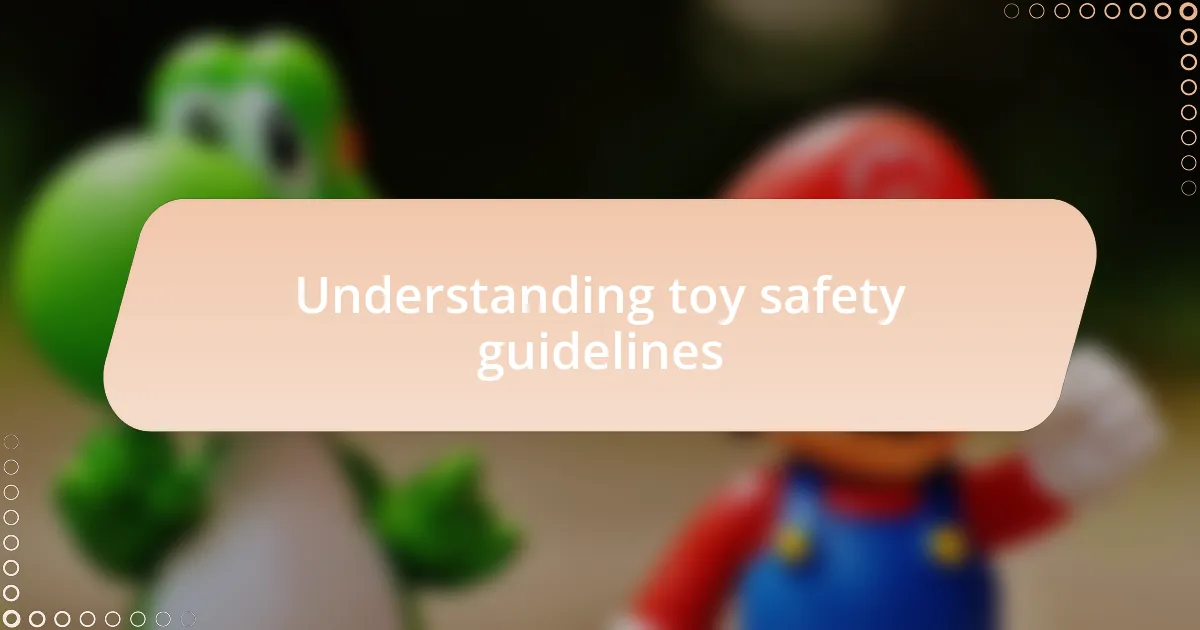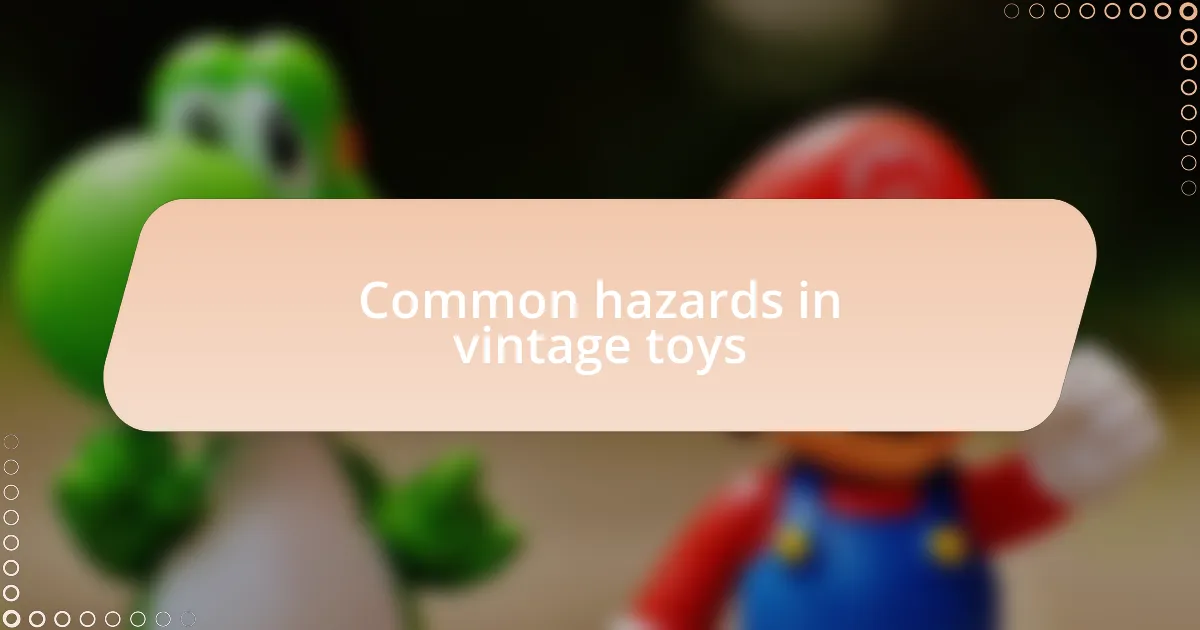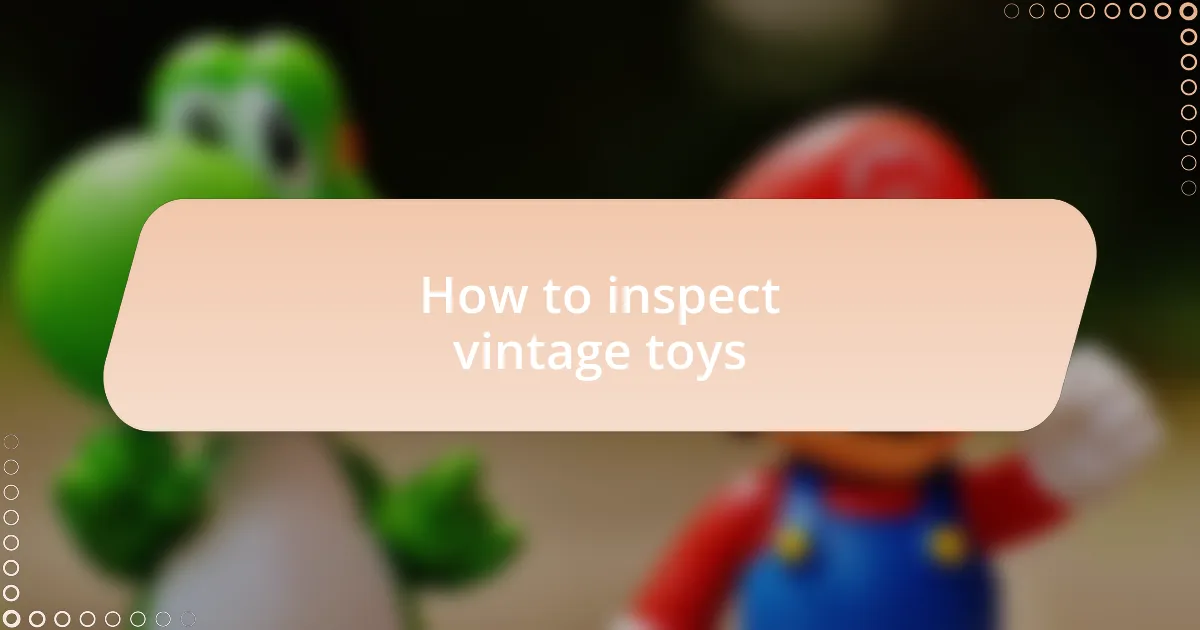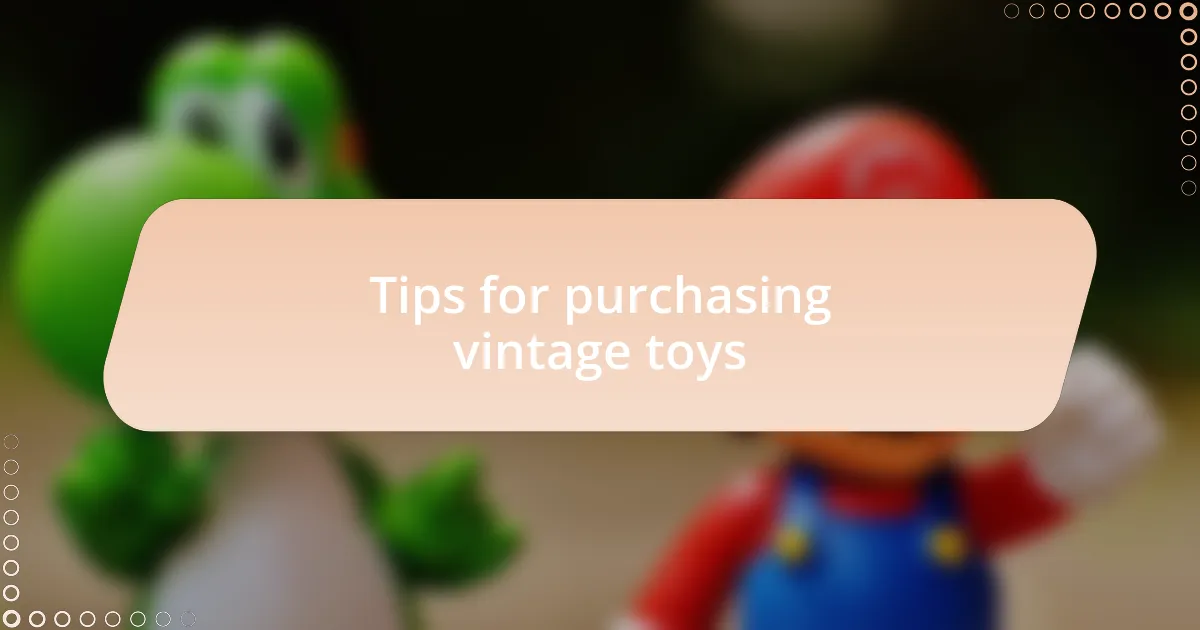Key takeaways:
- Understand age recommendations and materials used in toys to minimize safety risks, including checking for safety certifications like ASTM or EN71.
- Vintage toys may carry hidden dangers such as lead paint, small parts that pose choking hazards, or sharp edges that can lead to injuries.
- Inspect vintage toys thoroughly for loose parts, rust, or peeling paint to ensure they are safe for children to play with.
- Ask sellers about the toy’s history and seek documentation to ensure informed and safe purchasing decisions.

Understanding toy safety guidelines
When diving into toy safety guidelines, I often think back to my childhood experiences with vintage toys. I remember the excitement of tearing open a box, but there was always a whisper of caution in the back of my mind. Are those small pieces really safe? The truth is, understanding age recommendations is crucial; each toy is designed with specific age groups in mind to minimize risks.
Another important guideline revolves around the materials used in toys. I recall discovering that some of my favorite toys were made from materials that, when in doubt, raised a red flag for safety. For instance, lead paint was a serious concern back in the day. It’s vital to check for safety certifications like ASTM or EN71, which indicate that toys have been tested and are deemed safe for children.
Lastly, I often hear parents wondering about the importance of choking hazards. This is more than just a checklist item; it brings back memories of those tiny parts that could easily slip from view and end up where they shouldn’t. I recommend keeping an eye on small pieces, especially with toys meant for young children. It’s our responsibility to ensure that playtime remains a safe haven for laughter and creativity, free from unnecessary risks.

Importance of vintage toy safety
When considering the safety of vintage toys, I can’t help but reflect on the joy these items brought into my life. I remember the thrill of playing with a beautifully crafted wooden train set, but there was always the lingering worry about its age and condition. The importance of ensuring that these toys are safe cannot be overstated, especially when they carry the memories of our childhood. After all, who wants to risk the charm of nostalgia by overlooking potential hazards?
An eye-opening moment for me was discovering how certain materials used in vintage toys could pose hidden dangers. I once found a lovely tin robot at a flea market, and while I was drawn to its colorful exterior, I had to pause and think: Was it still safe after all these years? I realized that many vintage toys lack modern safety standards, making it essential to inspect them for any signs of wear or harmful substances. This vigilance can help preserve the delight of play while ensuring that our beloved relics are not just cherished, but also safe.
Perhaps you’ve pondered how family heirlooms can play a role in a child’s development. It’s heartwarming to see kids enjoying the same toys we grew up with, yet the safety of these toys is critical for that joy to continue. I urge fellow vintage enthusiasts to prioritize safety as part of the treasure hunt, keeping in mind that the true value lies not only in nostalgia but also in the assurance of a safe play environment for the little ones.

Common hazards in vintage toys
When it comes to vintage toys, one common hazard that often goes unnoticed is the presence of lead paint. I recall coming across a beautiful vintage doll at a garage sale, and while the nostalgia washed over me, I couldn’t help but think about the potential health risks associated with its vibrant colors. It’s a stark reminder that, while these toys may evoke warm memories, they can also harbor toxins that are harmful when children play with them. How many cherished items are lurking in attics, waiting to pose unseen dangers?
Another concern is small parts that can create choking hazards. I remember a classic board game from my childhood, complete with tiny pieces that could easily slip through little fingers. Those small tokens were part of the fun, but imagining a child accidently swallowing one gives me pause. Ensuring that toys are age-appropriate and free from small elements is crucial in maintaining a safe play environment. Isn’t it worth taking that extra minute to inspect toys before letting kids enjoy them?
Additionally, vintage toys might have sharp edges or broken components that can lead to injuries. I once found an old metal toy car that I was eager to restore, but as I examined it closely, I noticed rusty edges and a few sharp points. Even though the car was a nostalgic gem, the last thing I wanted was for a child to get hurt while playing with it. It’s important to look out for these safety issues, turning what should be joyful play into a safe experience for everyone involved.

How to inspect vintage toys
Inspecting vintage toys requires a keen eye and a touch of caution. I remember the thrill of finding a tin robot at an estate sale, its faded colors sparking childhood memories. Yet, as I prepared to add it to my collection, I made it a point to thoroughly check for any rust or wear, which can indicate deeper issues that may not be immediately visible.
During my inspections, I always prioritize looking for any small parts that might have come loose. I once encountered a delightful vintage train set, but as I examined the cars, I discovered a few loose couplings that could easily detach. This reminded me how important it is to ensure that every component is securely attached, especially when little hands will be around. After all, how much joy can these pieces bring if they’re a risk to the very children we want to share them with?
Lastly, I can’t stress enough the importance of checking for any peeling paint or labels that might be flaking off. A simple glance can reveal a potential hazard. As I inspected an old wooden rocking horse I had my eye on, I noticed some paint bubbling in places. I felt both the excitement of my find and the responsibility that came with it; ensuring safety is a crucial part of preserving the joy these toys can bring. After all, would I truly relish sharing a piece of my past if it posed a danger to my loved ones?

Tips for purchasing vintage toys
When purchasing vintage toys, it’s essential to ask the seller about the toy’s history. I remember once inquiring about a charming wind-up doll at a flea market. The vendor shared that it had belonged to her grandmother, adding an emotional depth to my purchase. Knowing its backstory not only gives the toy character but can also alert you to any potential safety concerns. Wouldn’t you want to ensure that you’re bringing home something with a safe and beloved history?
Don’t hesitate to ask for documentation or proof of authenticity, particularly for higher-value items. In one instance, I was drawn to a stunning collection of action figures but took a moment to request their provenance. The seller provided original packaging and a certificate that assured me of their value. This experience taught me that having this kind of assurance can guarantee a safer and smarter investment.
Another vital consideration is the toy’s materials. I once hesitated on a beautifully crafted wooden puzzle because I was unsure about the safety of the paint used on it. It’s crucial to do a bit of research beforehand. Understanding whether a toy was manufactured with lead paint or other harmful substances can save you from heartbreak down the line. Isn’t it better to leave a toy on the shelf than to risk your child’s safety for a shot at nostalgia?